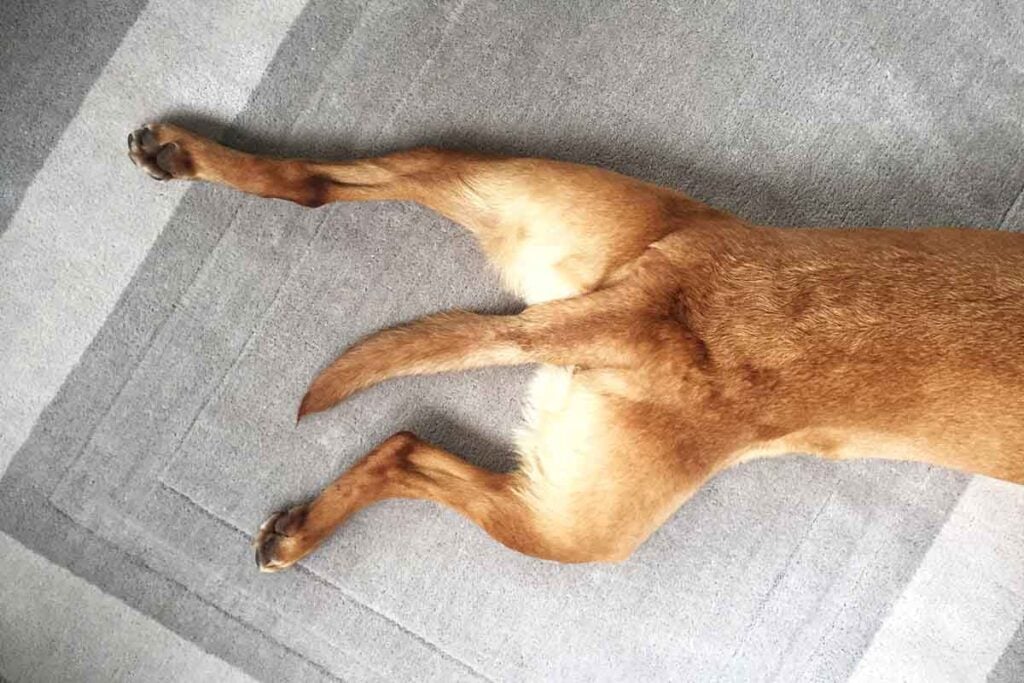Reviewed by: Dr. David Tittle, BVetMed, CertVA, GPCert(WVA&CPM), MRCVS
You probably didn’t know this funny resting position had a name, but splooting is fairly common among dogs. It has taken the internet by storm, and for good reason! Splooting is the term used to describe when a dog stretches out their hind legs behind them while laying down, resulting in a pose that looks both adorable and hilarious.
But splooting isn’t just a cute pose for social media – it’s comfortable for your dog and can be used as a form of body language communication. Why do dogs sploot, and what it can tell us about our furry friends?
Table of contents
- What is splooting?
- Why do dogs sploot?
- What does splooting say about your dog’s personality?
- Dogs who sploot
- Is splooting bad for dogs?
- When to be concerned
- How can ElleVet’s CBD + CBDA help dogs with joint discomfort?
- Bottom line on splooting
What is splooting?
Splooting refers to a dog (or other animal) lying on their belly on the ground, with their rear legs extended straight back and flat against the ground. The dog’s front legs remain tucked in, giving the pose a unique appearance that’s both endearing and amusing. While splooting may look uncomfortable, it’s actually a natural position for dogs to assume. It’s not uncommon to see dogs sploot out in the grass, on the couch, or even in their dog bed.
Why do dogs sploot?
The answer to the question of why dogs sploot is quite simple: because they like it! Dogs lie in whatever position feels good to them. Lying in the sploot position simply may feel comfortable to your dog.
Splooting can provide a good stretch. Some experts suggest that splooting may be a natural way for dogs to stretch and relax their muscles, especially after a long day of physical activity. By stretching out their hip muscles, splooting can be beneficial for dogs that are prone to joint discomfort. Additionally, splooting can help support pressure on their lower back and hips, which can be especially important for older dogs or those with spinal issues.
Splaying out completely flat against the cold ground can help a dog cool off. When the temperature rises, dogs may spread out their hind legs in a sploot to help regulate their body temperature. By exposing more of their skin to the air, they can cool off more efficiently. So, if you notice your dog splooting on a cool surface like tile or wood floors on a hot day, it’s likely because they’re trying to stay comfortable and cool. As always, make sure your dog has access to plenty of water and shade to stay hydrated and comfortable in hot weather.
What does splooting say about your dog’s personality?
Splooting can be a sign of a confident and relaxed dog, as they are comfortable enough to expose their vulnerable belly and hindquarters while in this position. Alternatively, dogs may sploot as a way to claim their territory. By spreading out and taking up more space, some dogs may sploot as a way to assert dominance.
Dogs who sploot
Splooting is often seen in breeds with short legs and long bodies, such as Corgis, Dachshunds, and Basset Hounds. The position helps support pressure off their spines and hips, and gives them a good stretch. While all breeds can sploot, this position is also common in:
- Brachycephalic dogs, whose shorter muzzles and smushed faces can make it more challenging for them to regulate their body temperature when they get hot.
- Thick-coated dogs, such as Huskies, Newfoundlands, Bernese Mountain Dogs, Sheepdogs, and many others.
Is splooting bad for dogs?
Some pet owners worry that if their dog is lying in the sploot position it might mean they have hip or joint issues. As it turns out, if your pup sploots a lot, it could actually mean that their hips are healthy. Young puppies often enjoy lying in the sploot position, likely due to the greater flexibility in their hips. Dogs with joint discomfort, on the other hand, do not typically like their hips being extended and would generally avoid laying stretched out.
When to be concerned
If, in addition to your dog splooting, you do notice signs of discomfort, it’s important to get your dog checked out by a veterinarian. Common signs that your dog may be experiencing joint discomfort can include:
- Limping, stiffness, or lameness
- Difficulty standing up
- Reluctance to climb stairs or jump into the car
- Loss of interest in toys, games, and walks
- Decreased appetite
- Restlessness, panting, and agitation
How can ElleVet’s CBD + CBDA help dogs with joint discomfort?
CBD + CBDA is a safe and effective option for addressing joint discomfort in dogs by working to improve discomfort. ElleVet’s CBD + CBDA chews, soft gels, and oil help your dog by modulating their response and perception of discomfort. In helping your dog address mobility issues and be more comfortable, ElleVet’s CBD + CBDA can lead to improved overall well-being!
As always, consult your veterinarian if your dog shows signs of joint discomfort. For any questions about ElleVet’s CBD + CBDA products or how CBD can help your canine companion have the best quality of life possible with less discomfort, give us a call (844-673-7287) or send us an email ([email protected]). We are here to help.
Bottom line on splooting
Dog splooting is a unique and amusing behavior that many pet owners enjoy witnessing—and capturing on camera! While some may be concerned about potential health issues or discomfort for their furry friends, experts agree that splooting is a natural and harmless way for dogs to stretch and relax. As with any other behavior, it’s important for pet owners to monitor their dog’s splooting habits and make sure they are comfortable. Overall, dog splooting is just another endearing quirk that makes our furry companions so lovable and entertaining.









